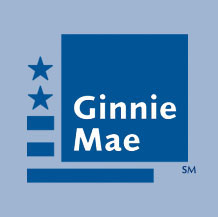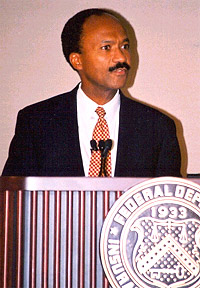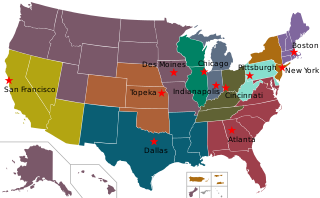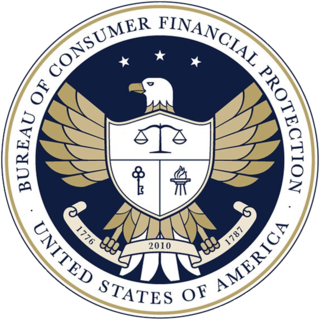
The Government National Mortgage Association (GNMA), or Ginnie Mae, is a government-owned corporation of the United States Federal Government within the Department of Housing and Urban Development (HUD). It was founded in 1968 and works to expand affordable housing by guaranteeing housing loans (mortgages) thereby lowering financing costs such as interest rates for those loans. It does that through guaranteeing to investors the on-time payment of mortgage-backed securities (MBS) even if the underlining mortgages go into default and the homes are foreclosed upon.

The Federal National Mortgage Association (FNMA), commonly known as Fannie Mae, is a United States government-sponsored enterprise (GSE) and, since 1968, a publicly traded company. Founded in 1938 during the Great Depression as part of the New Deal, the corporation's purpose is to expand the secondary mortgage market by securitizing mortgage loans in the form of mortgage-backed securities (MBS), allowing lenders to reinvest their assets into more lending and in effect increasing the number of lenders in the mortgage market by reducing the reliance on locally based savings and loan associations. Its sister organization is the Federal Home Loan Mortgage Corporation (FHLMC), better known as Freddie Mac. As of 2018, Fannie Mae is ranked number 21 on the Fortune 500 rankings of the largest United States corporations by total revenue.

Franklin Delano Raines also known as Frank Raines is an American business executive. He is the former chairman and chief executive officer of the Federal National Mortgage Association, commonly known as Fannie Mae, who served as White House budget director under President Bill Clinton. His role leading Fannie Mae has come under scrutiny. He has been called one of the "25 People to Blame for the Financial Crisis" according to Time magazine.

The Federal Home Loan Mortgage Corporation (FHLMC), known as Freddie Mac, is a public government-sponsored enterprise (GSE), headquartered in Tysons Corner, Virginia. Freddie Mac is ranked No. 41 on the 2020 Fortune 500 list of the largest United States corporations by total revenue, and has $2.063 trillion assets under management.

The Federal Home Loan Banks are 11 U.S. government-sponsored banks that provide reliable liquidity to the members of financial institutions to support housing finance and community investment. With their members, the FHLBanks represents the largest collective source of home mortgage and community credit in the United States.
A government-sponsored enterprise (GSE) is a type of financial services corporation created by the United States Congress. Their intended function is to enhance the flow of credit to targeted sectors of the economy, to make those segments of the capital market more efficient and transparent, and to reduce the risk to investors and other suppliers of capital. The desired effect of the GSEs is to enhance the availability and reduce the cost of credit to the targeted borrowing sectors primarily by reducing the risk of capital losses to investors: agriculture, home finance and education. Well known GSEs are the Federal National Mortgage Association, or Fannie Mae, and the Federal Home Loan Mortgage Corporation, or Freddie Mac.

The Office of Federal Housing Enterprise Oversight (OFHEO) was an agency within the Department of Housing and Urban Development of the United States of America. It was charged with ensuring the capital adequacy and financial safety and soundness of two government sponsored enterprises—the Federal National Mortgage Association and the Federal Home Loan Mortgage Corporation. It was established by the Federal Housing Enterprises Financial Safety and Soundness Act of 1992.
In the United States, a conforming loan is a mortgage loan that conforms to GSE guidelines. The most well-known guideline is the size of the loan, which, for 2019, was generally limited to $484,350 for single family homes in the continental US. Other guidelines include borrower's loan-to-value ratio, debt-to-income ratio, credit score and history, documentation requirements, etc.
The United States Housing and Economic Recovery Act of 2008 was designed primarily to address the subprime mortgage crisis. It authorized the Federal Housing Administration to guarantee up to $300 billion in new 30-year fixed rate mortgages for subprime borrowers if lenders wrote down principal loan balances to 90 percent of current appraisal value. It was intended to restore confidence in Fannie Mae and Freddie Mac by strengthening regulations and injecting capital into the two large U.S. suppliers of mortgage funding. States are authorized to refinance subprime loans using mortgage revenue bonds. Enactment of the Act led to the government conservatorship of Fannie Mae and Freddie Mac.

The Federal Housing Finance Agency (FHFA) is an independent federal agency in the United States created as the successor regulatory agency of the Federal Housing Finance Board (FHFB), the Office of Federal Housing Enterprise Oversight (OFHEO), and the U.S. Department of Housing and Urban Development government-sponsored enterprise mission team, absorbing the powers and regulatory authority of both entities, with expanded legal and regulatory authority, including the ability to place government sponsored enterprises (GSEs) into receivership or conservatorship.

The federal takeover of Fannie Mae and Freddie Mac was the placing into conservatorship of the government-sponsored enterprises (GSEs) Federal National Mortgage Association and Federal Home Loan Mortgage Corporation by the U.S. Treasury in September 2008. It was one of the financial events among many in the subprime mortgage crisis.
James B. Lockhart III is an American U.S. Navy officer, business executive, and, since September 2009, Vice Chairman of WL Ross & Co. LLC, which manages $9 billion of private equity investments, a hedge fund and a Mortgage Recovery Fund. It is a subsidiary of Invesco, a Fortune 500 investment management firm. He coordinates WL Ross's investments in financial services firms and mortgages. Lockhart serves co-chairs the Bipartisan Policy Center's Commission on Retirement Security and Personal Savings.
The U.S. subprime mortgage crisis was a set of events and conditions that led to a financial crisis and subsequent recession that began in 2007. It was characterized by a rise in subprime mortgage delinquencies and foreclosures, and the resulting decline of securities backed by said mortgages. Several major financial institutions collapsed in September 2008, with significant disruption in the flow of credit to businesses and consumers and the onset of a severe global recession.
Loan modification is the systematic alteration of mortgage loan agreements that help those having problems making the payments by reducing interest rates, monthly payments or principal balances. Lending institutions could make one or more of these changes to relieve financial pressure on borrowers to prevent the condition of foreclosure. Loan modifications have been practiced in the United States since The 2008 Crash Of The Housing Market from Washington Mutual, Chase Home Finance, Chase, JP Morgan & Chase, other contributors like MER's. Crimes of Mortgage ad Real Estate Staff had long assisted nd finally the squeaky will could not continue as their deviant practices broke the state and crashed. Modification owners either ordered by The United States Department of Housing, The United States IRS or President Obamas letters from Note Holders came to those various departments asking for the Democratic process to help them keep their homes and protection them from explosion. Thus the birth of Modifications. It is yet to date for clarity how theses enforcements came into existence and except b whom, but t is certain that note holders form the Midwest reached out in the Democratic Process for assistance. FBI Mortgage Fraud Department came into existence. Modifications HMAP HARP were also birthed to help note holders get Justice through reduced mortgage by making terms legal. Modification of mortgage terms was introduced by IRS staff addressing the crisis called the HAMP TEAMS that went across the United States desiring the new products to assist homeowners that were victims of predatory lending practices, unethical staff, brokers, attorneys and lenders that contributed to the crash. Modification were a fix to the crash as litigation has ensued as the lenders reorganized and renamed the lending institutions and government agencies are to closely monitor them. Prior to modifications loan holders that experiences crisis would use Loan assumptions and Loan transfers to keep the note in the 1930s. During the Great Depression, loan transfers, loan assumption, and loan bail out programs took place at the state level in an effort to reduce levels of loan foreclosures while the Federal Bureau of Investigation, Federal Trade Commission, Comptroller, the United States Government and State Government responded to lending institution violations of law in these arenas by setting public court records that are legal precedence of such illegal actions. The legal precedents and reporting agencies were created to address the violations of laws to consumers while the Modifications were created to assist the consumers that are victims of predatory lending practices. During the so-called "Great Recession" of the early 21st century, loan modification became a matter of national policy, with various actions taken to alter mortgage loan terms to prevent further economic destabilization. Due to absorbent personal profits nothing has been done to educate Homeowners or Creditors that this money from equity, escrow is truly theirs the Loan Note Holder and it is their monetary rights as the real prize and reason for the Housing Crash was the profit n obtaining the mortgage holders Escrow. The Escrow and Equity that is accursed form the Note Holders payments various staff through the United States claimed as recorded and cashed by all staff in real-estate from local residential Tax Assessing Staff, Real Estate Staff, Ordinance Staff, Police Staff, Brokers, attorneys, lending institutional staff but typically Attorneys who are also typically the owners or Rental properties that are trained through Bankruptcies'. that collect the Escrow that is rightfully the Homeowners but because most Homeowners are unaware of what money is due them and how they can loose their escrow. Most Creditors are unaware that as the note holder that the Note Holder are due an annual or semi annual equity check and again bank or other lending and or legal intuitions staff claim this monies instead. This money Note Holders were unaware of is the prize of real estate and the cause of the Real Estate Crash of 2008 where Lending Institutions provided mortgages to people years prior they know they would eventually loose with Loan holders purchasing Balloon Mortgages lending product that is designed to make fast money off the note holder whom is always typically unaware of their escrow, equity and that are further victimized by conferences and books on HOW TO MAKE MONEY IN REAL STATE - when in fact the money is the Note Holder. The key of the crash was not the House, but the loan product used and the interest and money that was accrued form the note holders that staff too immorally. The immoral and illegal actions of predatory lending station and their staff began with the inception of balloon mortgages although illegal activity has always existed in the arena, yet the crash created "Watch Dog" like HAMP TEAM, IRS, COMPTROLLER< Federal Trade Commission Consumer Protection Bureau, FBI, CIA, Local Police Department, ICE and other watch dog agencies came into existence to examine if houses were purchased through a processed check at Government Debited office as many obtained free homes illegally. Many were incarcerated for such illegal actions. Modifications fixed the Notes to proper lower interest, escrow, tax fees that staff typically raised for no reason. Many people from various arenas involved in reals estate have been incarcerated for these actions as well as other illegal actions like charging for a modification. Additionally Modifications were also made to address the falsifications such as inappropriate mortgage charges, filing of fraudulently deeds, reporting of and at times filing of fraudulent mortgages that were already paid off that were fraudulently continued by lenders staff and attorneys or brokers or anyone in the Real Estate Chain through the issues of real estate terms to continue to violate United States Laws, contract law and legal precedence where collusion was often done again to defraud and steal from the Note Holder was such a common practice that was evidence as to why the Mortgage Crash in 2008 occurred for the purpose of winning the prize of stealing from Homeowners and those that foreclosed was actually often purposefully for these monies note holders were unaware of to be obtained which was why Balloon mortgages and loans were given to the staff in the Real Estate Market with the hope and the expectation that the loan holders would default as it offered opportunity to commit illegal transactions of obtaining the homeowners funds. While such scams were addressed through modifications in 2008. The Market relied heavily on Consumers ignorance to prosper, ignorance of real estate terms, ignorance on what they were to be charged properly for unethical financial gain and while staff in real estates lending arenas mingled terms to deceive y deliberate confusion consumers out of cash and homes while the USA Government provided Justice through President Obama's Inception and IRS Inception of Modifications which addressed these unethical profits in Reals Estate. It was in 2009 that HARP, HAMP and Modifications were introduced to stop the victimization of Note Holders. Taking on the Banks that ran USA Government was a great and dangerous undertaking that made America Great Again as Justice for Consumers reigned. Legal action taken against institutions that have such business practices can be viewed in State Code of Law and Federal Law on precedent cases that are available to the public. Finally, It had been unlawful to be charged by an attorney to modify as well as for banking staff to modify terms to increase a mortgage and or change lending product to a balloon in an concerted effort to make homeowner foreclose which is also illegal, computer fraud and not the governments intended purpose or definition of a modification. There are reputable companies that are trained to assist with foreclosure defense and home retention options. In addition, hud.gov offers a variety of non-profit agencies that offer assistance.

Josephine Laura Staton is a United States District Judge of the United States District Court for the Central District of California.

The Consumer Financial Protection Bureau (CFPB) is an agency of the United States government responsible for consumer protection in the financial sector. CFPB's jurisdiction includes banks, credit unions, securities firms, payday lenders, mortgage-servicing operations, foreclosure relief services, debt collectors and other financial companies operating in the United States. Since its founding, the CFPB has "engaged the 21st century" by using technology tools to monitor how financial entities used social media and algorithms to target consumers.

People of the State of California v. Federal Housing Finance Agency was a California state case in which several California-based plaintiffs filed suit against the Federal Housing Finance Agency (FHFA) for creating a lending rule that impeded the Property Assessed Clean Energy (PACE) program, a program in which property owners repay energy-related property improvements gradually over time as an addition to their property tax.
This is an unannotated bibliography of writings about Fannie Mae and Freddie Mac as well as some material that covers other government sponsored enterprises such as the Federal Home Loan Bank System. While it is comprehensive, it is not exhaustive, with a focus on work published through 2011 by government agencies, economists, legal and policy scholars, private sector analysts and think tanks. It does not include Congressional testimony and shorter works. This bibliography has been posted on Wikipedia so that others can make additions to it. The original document may be found on SSRN. Please continue to follow guidelines consistent with the Chicago Manual of Style when editing this bibliography.

The Budget and Accounting Transparency Act of 2014 is a bill that would modify the budgetary treatment of federal credit programs. The bill would require that the cost of direct loans or loan guarantees be recognized in the federal budget on a fair-value basis using guidelines set forth by the Financial Accounting Standards Board. The bill would also require the federal budget to reflect the net impact of programs administered by Fannie Mae and Freddie Mac. The changes made by the bill would mean that Fannie Mae and Freddie Mac were counted on the budget instead of considered separately and would mean that the debt of those two programs would be included in the national debt. These programs themselves would not be changed, but how they are accounted for in the United States federal budget would be. The goal of the bill is to improve the accuracy of how some programs are accounted for in the federal budget.
Seila Law LLC v. Consumer Financial Protection Bureau, 591 U.S. ____ (2020) was a U.S. Supreme Court case which determined that the structure of the Consumer Financial Protection Bureau (CFPB), with a single director who could only be removed from office "for cause", violates the separation of powers. The Court's 5–4 decision, issued on June 29, 2020, recognized that the directorship position was severable from the statute that established the CFPB, allowing the CFPB to continue to operate.











